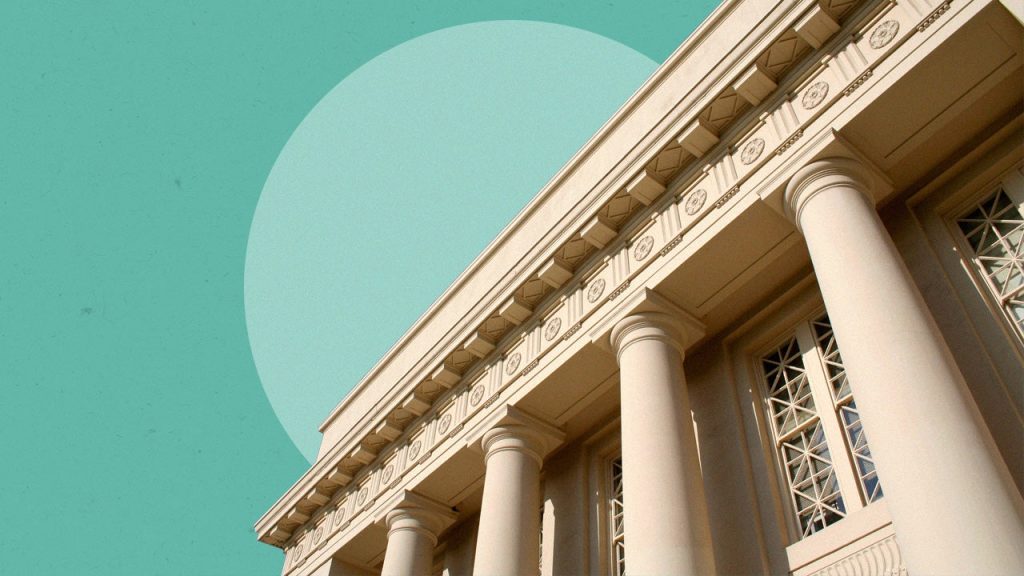Whether they advertise on television, at sports arenas or have a branch in your neighborhood, there’s no avoiding the largest banks in the U.S.
The 15 largest banks held a combined total of around $14 trillion in assets as of March 31. Every so often, there are changes to the ranking of this exclusive club. Larger banks trade places with one another and smaller banks drop out, replaced by faster-growing rivals. Mergers and acquisitions can also play a part in this shuffle.
What’s more, a bank failure could cause consolidation of the largest banks in the U.S., such as in 2023 when JPMorgan Chase assumed all of First Republic Bank’s deposits and nearly all of its assets. First Republic was the second-largest bank failure since Washington Mutual in 2008, which JPMorgan Chase also acquired.
Here are the biggest banks in the U.S. by consolidated assets, according to the latest data from the Federal Reserve.
| RANK | BANK NAME | TOTAL ASSETS | PREVIOUS RANK |
|---|---|---|---|
| 1 | JPMorgan Chase | $3.64 trillion | 1 |
| 2 | Bank of America | $2.62 trillion | 2 |
| 3 | Citigroup | $1.76 trillion | 4 |
| 4 | Wells Fargo | $1.71 trillion | 3 |
| 5 | U.S. Bancorp | $659 billion | 5 |
| 6 | Goldman Sachs | $598.5 billion | 6 |
| 7 | PNC Financial Services | $549.3 billion | 7 |
| 8 | Truist Financial | $527.5 billion | 8 |
| 9 | Capital One Financial | $490.6 billion | 9 |
| 10 | State Street | $368.2 billion | 11 |
| 11 | TD Group Holdings | $366.5 billion | 10 |
| 12 | Bank of New York Mellon | $356.3 billion | 12 |
| 13 | BMO | $257 billion | 13 |
| 14 | Morgan Stanley | $234.5 billion | 14 |
| 15 | First Citizens Bank | $228.6 billion | 15 |
SOURCE: Board of Governors of the Federal Reserve System
1. JPMorgan Chase
Chase Bank is the consumer banking division of JPMorgan Chase. It currently has more than 4,700 branches and more than 15,000 ATMs.
Chase has branches in all of the 48 states in the continental U.S. and has more branches than any other bank in the U.S.
- Assets: $3.64 trillion
- Headquarters: New York
2. Bank of America
Bank of America serves about 69 million consumers and small business clients worldwide. Like many of the biggest banks, it offers robust digital tools that include a versatile mobile app. In early 2022, Bank of America eliminated its nonsufficient funds (NSF) fee and reduced its overdraft fee, following an industry trend.
- Assets: $2.62 trillion
- Headquarters: Charlotte, N.C.
3. Citigroup
Citigroup is a global financial services corporation. Its retail banking division has about 672 locations in the U.S. and has a presence in nearly 180 jurisdictions and countries, according to its website. U.S. customers can also access more than 65,000 fee-free ATMs.
- Assets: $1.76 trillion
- Headquarters: New York
4. Wells Fargo
Wells Fargo was founded in 1852. In addition to its main app, Wells Fargo has introduced a savings app and a mobile banking app geared toward millennials. The bank has rebranded and is focusing on repairing its fractured relationship with customers after a series of missteps. But in June 2025, the Federal Reserve removed the asset growth restriction the bank had been under since 2018.
- Assets: $1.71 trillion
- Headquarters: San Francisco
5. U.S. Bancorp
U.S. Bancorp is the bank holding company and parent company of U.S. Bank. What we’ve come to know as the fifth-largest commercial bank by assets began in 1863 as the First National Bank of Cincinnati. Multiple mergers led to the formation of the bank known today for its extensive branch network and investment in improving its digital offerings.
U.S Bank has branches in more than half of the 50 states.
- Assets: $ 659 billion
- Headquarters: Minneapolis
6. Goldman Sachs
Goldman Sachs is a global investment banking, management and securities firm. Its clients have access to a variety of financial services, including banking products through Marcus, its online banking arm that made its debut in fall 2016 and began offering personal loans.
- Assets: $ 598.5 billion
- Headquarters: New York
7. PNC Financial Services
PNC was founded as Pittsburgh Trust and Savings Co. in 1845. Today, the bank has around 2,300 locations in 28 states and Washington, D.C.
PNC agreed to acquire BBVA USA for $11.6 billion in Nov. 2020, and the deal closed June 1, 2021.
- Assets: $549.3 billion
- Headquarters: Pittsburgh
8. Truist Financial
Truist is the bank formed by the merger of BB&T and SunTrust. Truist provides financial services to about 14 million client relationships and consumer households as of 2024, according to the bank’s annual report.
Prior to merging in 2019, BB&T and SunTrust were ranked the 11th and 12th largest banks by assets, respectively, as of Sept. 30, 2019. The two banks have had more than 275 years of combined history.
- Assets: $527.5 billion
- Headquarters: Charlotte, N.C.
9. Capital One Financial
Capital One is a Fortune 500 company with subsidiaries that include Capital One Bank. In addition to branches on the East Coast, it also has branches in Texas and Louisiana. Capital One bank customers in select cities have access to Capital One Cafés, which are coffee shops with free Wi-Fi where visitors can open accounts and attend financial workshops. Capital One was named the best big bank as part of the 2025 Bankrate Awards.
- Assets: $490.6 billion
- Headquarters: McLean, Va.
10. State Street
Founded in 1792, State Street Corp. is a financial services and asset management company with about 40,000 employees and a global presence in more than 100 markets. Services include investment research and trading and investment management. In addition to being one of the top 15 largest banks in the US, it’s also the fourth-largest asset manager worldwide, according to its website.
- Assets: $368.2 billion
- Headquarters: Boston
11. TD Group Holdings
TD Bank is the U.S. commercial banking arm of Canada’s TD Bank Group. Customers have access to mortgages, deposit accounts, credit cards and products for commercial and small business clients. The bank has more than 1,100 branches along the East Coast and provides access to around 2,600 ATMs.
- Assets: $366.5 billion
- Headquarters: Cherry Hill, N.J.
12. Bank of New York Mellon
When the New York Stock Exchange opened in 1792, the Bank of New York was the first company traded. Today, Bank of New York Mellon is an investment company that serves different corporations and institutions as well as individual investors. Private banking services are available for its wealthy clients.
- Assets: $356.3 billion
- Headquarters: New York
13. BMO
BMO has more than 1,000 locations in the U.S. Some of its branches are located in Arizona, California, Colorado, Illinois, Florida, Indiana, Missouri, Minnesota and Wisconsin.
In early 2023, BMO completed the acquisition of Bank of the West. That transaction helped BMO gain nearly 1.8 million customers, according to a BMO press release.
- Assets: $257 billion
- Headquarters: Chicago
14. Morgan Stanley
Morgan Stanley was founded in 1935. The financial institution operates in more than 40 countries and has over 80,000 employees. Morgan Stanley completed the acquisition of E-Trade in October 2020.
- Assets:$ 234.5 billion
- Headquarters: New York
15. First Citizens Bank
First Citizens Bank has been around for more than 125 years. In early 2022, CIT Bank merged with First Citizens Bank.
As of Dec. 31, 2021, CIT Bank was the 48th largest bank in the U.S., based on consolidated assets (First Citizens was the 40th largest bank back then).
- Assets: $ 228.6 billion
- Headquarters: Raleigh, N.C.
Pros and cons of large banks
Although large banks often provide the conveniences of large branch and ATM networks, and sometimes generous bonuses, they’re often not a source of high-yield accounts. Here’s the breakdown of the pros and cons of large banks.
Pros of the largest banks
- They might have a lot of brick-and-mortar locations near where you live or work.
- The largest banks might have a lot of ATMs that are convenient to you.
- You can usually find any type of bank account or lending product that you need with the same bank.
- Large banks are generally known for offering bank account bonuses more often than online-only banks.
Cons of the largest banks
Are bonuses at large banks worth making a switch?
A bank account bonus can be a reason to switch banks, but generally banking is a long-term relationship. Checking account holders keep a checking account for an average of 19 years, according to Bankrate’s latest Checking Account Survey. But you have to do the math: sometimes a high-yield savings account for your savings will end up being a better deal than a bank account bonus at a brick-and-mortar bank. But a bank account bonus at a bank insured by the Federal Deposit Insurance Corp. (FDIC) that’s offering a competitive yield, is an offer that you should consider since they’re not available often.
Branch and ATM networks of major banks
The largest banks generally have ATMs in cities and regions where they have brick-and-mortar locations. This can be good if you use ATMs and they’re near where you live and work. Some online-only banks have very large ATM networks across the U.S. and some brick-and-mortar banks, such as BMO Bank and PNC Bank, are starting to join large ATM networks.
It’s good to be in a large ATM network because ATM fees can be costly. The average total out-of-network ATM fee is $4.77, according to Bankrate’s 2024 checking account and ATM fee study. While the number of ATMs is nice, the key is they have to be in locations convenient for you.
When deciding on a new bank, look for one that will reimburse some or even all out-of-network fees that another bank charges you for using its ATM.
How to seamlessly get money into and out of your accounts is a key consideration when picking a financial institution. Part of this is making sure you have adequate access to free ATM withdrawals in those instances when you need cash.
— Greg McBride | CFA, Bankrate chief financial analyst
Bottom Line
The 15 largest banks in the US hold trillions of dollars in assets and constantly undergo changes through mergers, acquisitions, and, on rare occasions, failures. These banks offer a variety of services and have a wide reach through their numerous branches and digital tools.
As consumers, it is important to stay informed about the financial landscape and make informed decisions when choosing a bank. Whether it’s for personal or business needs, consider exploring the options offered by these top banks to find the best fit for your financial goals. Stay updated on industry trends and developments, and make sure to regularly review and manage your accounts for optimal financial health.
Why we ask for feedback
Your feedback helps us improve our content and services. It takes less than a minute to
complete.
Your responses are anonymous and will only be used for improving our website.
Help us improve our content
Read the full article here









